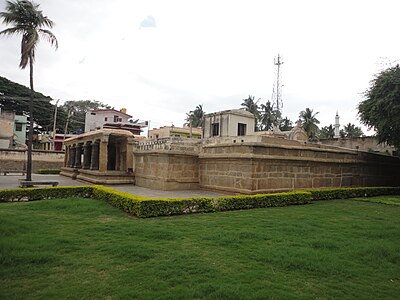
Kolar district is a district in the state of Karnataka, India.
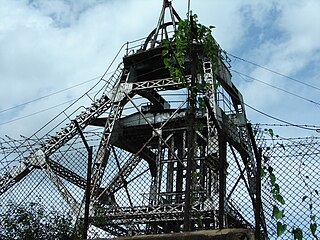
Kolar Gold Fields (K.G.F.) is a mining region in K.G.F. taluk (township), Kolar district, Karnataka, India. It is headquartered in Robertsonpet, where employees of Bharat Gold Mines Limited (BGML) and BEML Limited and their families live. K.G.F. is about 30 kilometres (19 mi) from Kolar, 100 kilometres (62 mi) from Bengaluru, capital of Karnataka. Over a century, the town has been known for gold mining. The mine closed on 28 February 2001 due to a fall in gold prices, despite gold still being present there. One of India's first power-generation units was built in 1889 to support mining operations. The mine complex hosted some particle physics experiments between the 1960s and 1992.

Tamil copper-plate inscriptions are copper-plate records of grants of villages, plots of cultivable lands or other privileges to private individuals or public institutions by the members of the various South Indian royal dynasties. The study of these inscriptions has been especially important in reconstructing the history of Tamil Nadu. The grants range in date from the 10th century C.E. to the mid-19th century C.E. A large number of them belong to the pandyas, the Cholas. These plates are valuable epigraphically as they give us an insight into the social conditions of medieval South India; they also help us fill chronological gaps in the connected history of the ruling dynasties. For example, the Leyden grant of Parantaka Chola and those of Parakesari Uttama Chola are among the most important, although the most useful part, i.e., the genealogical section, of the latter's plates seems to have been lost

Vikrama Chola, known as Kō Parakēsari Varman, was a 12th-century ruler of the Chola Empire in southern India. He succeeded his father Kulothunga I to the throne. Vikrama Chola was crowned as the heir-apparent by his father early in his life. He was appointed as viceroy of the Vengi province in 1089 C.E., succeeding his brother Rajaraja Chodaganga. Vikrama during his tenure successfully managed to check the ambitions of the Western Chalukya Vikramaditya VI on the Vengi kingdom.Vikrama Chola inherited the territories which included Tamil Nadu and some parts of Andhra Pradesh.

Magadi is a town and taluk located in Bengaluru South district, Karnataka, India.
Ereyanga was the son of Vinayaditya and distinguished himself as a Chalukya feudatory during their campaigns against Dhara of Malwa. Though he remained the Yuvaraja or crown prince for several decades, his rule as a monarch of Hoysala Empire was short. He was a Jain by faith and took the title 'Vira Ganga'.
Epigraphia Carnatica is a set of books on epigraphy of the Old Mysore region of India, compiled by Benjamin Lewis Rice, the Director of the Mysore Archaeological Department. Over a period of about ten years between 1894 and 1905, Rice published the books in a set of twelve volumes. The books contain the study of about 9,000 inscriptions from lithic surfaces and copper plates, which were found in the region. Apart from the original inscription, an English translation and a Roman transliteration are also provided.
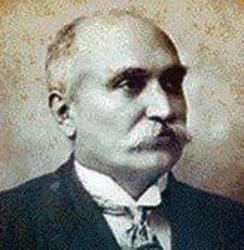
Benjamin Lewis Rice, popularly known as B. L. Rice, was a British historian, archaeologist and educationist. He is known for his pioneering work in deciphering inscriptions, especially in Kannada, and in Sanskrit inscriptions in the Kingdom of Mysore and is eulogized as Shasanapitamaha or Purathathva Pitamaha Rice's researches were published as the voluminous Epigraphia Carnatica which contains translations of about 9000 inscriptions he found in the Old Mysore area. Rice also compiled the much acclaimed Mysore Gazetteer which still remains the primary source of information for most places in Mysore and neighbouring Coorg. Rice served with distinction in the Mysore civil service and as first Director of the Mysore State Archaeology Department.

Halasuru Someshwara Temple is located in the neighborhood of Halasuru in Bangalore, Karnataka, India. It is one of the old temples in the city dating back to the Chola period, it is dedicated to the Hindu god Shiva. Major additions or modifications were made during the late Vijayanagara Empire period under the rule of Hiriya Kempe Gowda II.
Chokkanathaswamy temple, at Domlur in the Indian city of Bangalore, Karnataka, India, is dedicated to the deity known as Chokkanathaswamy or Chokka Perumal. It is one of the oldest temples in the city. The temple has numerous Kannada and Tamil inscriptions that have been documented in the Epigraphia Carnatica Vol 9, Bangalore District (1905ed). Based on these inscriptions the temple is at least as old as 1200 CE.
Old Madiwala Sri Someshwara Temple located in Bangalore city, Karnataka, India is dedicated to the deity Someshwara. It is one among the oldest temples in the city and dates back to the Chola Empire period. The temple belongs to the early 12th century.(1247 AD).

The Ranganatha Swamy Temple at Nirthadi, is a post-Vijayanagara Empire re-construction. Nirthadi is a village in the Davangere district of Karnataka state, India. According to noted historian and epigraphist Benjamin Lewis Rice, a Kannada language inscription dated 1698 AD in the temple premise describes the destruction of the original temple by the armies of Mogul emperor Aurangzeb in 1696 AD. The Chitradurga chief Baramappa Nayaka (r.1689–1721) rebuilt the temple in 1698 AD. The monument is protected by the Karnataka state division of Archaeological Survey of India.
There are nearly a thousand inscriptions in Tamil in the Southern Karnataka districts of Bangalore, Mysore, Kolar and Mandya in India. Nearly one third of these inscriptions are found in the Kolar District. Of all the inscriptions collected and published in the Epigraphia Carnatica Vol X for Kolar district, a fourth are in Tamil. The Tamil inscriptions start to appear around 1000 AD, after the conquest of the region by the Chola dynasty king Rajaraja I. Even after the Cholas left the area, the Hoysala and later the Vijaynagar kingdoms continued to use Tamil in the inscriptions.

Mysore Hatti Krishna Iyengar was an Indian historian, archaeologist, epigraphist and authority in Indian numismatics. He pioneered the new field of Indology involving the study of Indian culture, history, music and traditions from a historical perspective. He is credited with the discovery of one of the oldest Kannada inscriptions, the Halmidi inscription, dating back to 350 A. D. He also discovered the remains of the city of Isila near Brahmagiri during his excavations at Chandravalli, Chitradurga. The forgotten tomb of Shahaji was traced by M. H. Krishna during his years at the Mysore Archaeological Department. His years at the Archaeology Department saw him churn out many of excavation reports and these were later published in successive volumes of Epigraphia Carnatica. During Krishna's tenure at Bangalore, he was instrumental in cataloguing close to 6000 coins in the archives of the archaeology department there. He was trained at the University College, London under Ernest Arthur Gardner. and would later accompany Sir Flinders Petrie in his excavations in Egypt.
Vira Ramanatha was a king of the southern portion of the Hoysala Empire. In 1254 CE, Hoysala king Vira Someshwara divided his kingdom between his two sons, Narasimha III who ruled from Halebidu, their original capital, had got the greater part of the ancestral kingdom and Vira Ramanatha Deva obtained the remaining part consisting of the present Kolar district and the Tamil territories conquered by the Hoysalas in the south, and ruled from Kannanur Kuppam near Srirangam. Like his father Narasimha II, Someshwara stayed back at Kannanur with Ramanatha where he was killed in 1262/1263 CE in a war with Sadayavarman Sundara Pandyan I of the Pandya dynasty.

Domlur is a locality in the eastern part of Bengaluru city in India. Domlur is a historic places as indicated in the 18 inscriptions spanning the period 1200-1440CE found there. Of these, 16 inscriptions are at the Chokkanathaswamy Temple dedicated to the deity Chokkanathaswamy or the Chokka Perumal [the Hindu God Vishnu]. Of these eleven inscriptions are from the period 1200-1440 CE and have been documented earlier in Epigraphia Carnatica, Vol 9, these are mostly donatory inscriptions for the deity Chokkanathaswamy and for the Someshwara temple (non-existent).
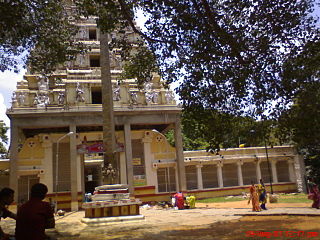
The Basavanagudi Inscriptions are a set of three Kannada and one Tamil inscriptions that can be found in the locality of Basavanagudi. Of the four, three Kannada inscriptions are physically present and the fourth Tamil inscription's physical status remains unknown. The available Kannada inscriptions can be found in Bugle rock park and Dodda Basavana Gudi or Big bull temple. Two inscriptions found in the vicinity of Dodda Basavana Gudi or Big bull temple, both describe the Vrishabhavati river's origin as coming from the feet of the Basava idol in the temple's sanctum and flowing westwards thereon as Paschimavahini. The two inscriptions can be found: one on the pedestal of the Basava deity in the sanctum and the other on a boulder in the shrubbery surrounding the temple. Two more inscriptions that are published, one is a one line Tamil inscription in Grantha script published in Epigraphia Carnatica and is about possible donatory inscription to the Chokkanathaswamy Temple in Domlur, a locality in Bengaluru, its physical status is not known at present and the other is a one line Kannada inscription in the Kannada script published in Itihasa Darshana Journal and is present on a boulder in the Bugle rock park in Basavanagudi is about one Deevatige Soma.
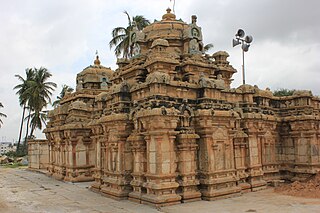
Begur is a locality in Bengaluru South which stands as a testament to ancient Bengaluru, with historical evidence dating back to c. 6th century CE. It was formerly known as Bempur, Veppur, and Behur, and served as a significant administrative center, playing a vital role in the evolution of Bengaluru to a modern global metropolis.

Agara is a Panchayat-village in Bengaluru located on the Outer Ring Road, near Koramangala and HSR Layout. Three inscriptions were documented and published from the Agara locality, two of which are documented but the physical status is not known. The inscriptions range over a period from the 9th Century CE to 16th Century CE. The inscriptions records various donations done by individuals during the reign of the rulers of the Western Ganga and Karnataka (Vijayanagara) kingdoms. The 9th century CE Sriyamayya inscription mentions the fixing of Sluices of a tank, though it doesn't explicitly mention Agara Tank, the location of the inscription as documented in the Volume 9 of the Epigraphia carnatica as near the tank embankment is a sufficient affirmation to infer that the inscription was indeed referring to the Agara Tank, making it one of the earliest documented tank of Bengaluru, approximately 1150–1200 years old.

Belathur, a sub-locality in Kadugodi, is home to a 15th-century CE Kannada donatory inscription that records a donation by a Devijeeya who erected a pillar for the Tirumala deity and also that he donated four Khandugas of land for the purpose of neivedya (food) offerings to the deity, it was commissioned during the rule of Saaraki's Pemayanayka's son Pemeyanayaka, a feudal chief under the king Devaraya II of the Karnataka Empire. Saraki as mentioned in this inscription is a suburb in Bengaluru city. This inscription gives a genealogy of four generations Toravali naadu's rulers as Maachideva-Devijeeya-Chokkijeeya-Devijeeya, Toravali naadu is an administrative in the erstwhile empire, the geographic boundaries of this region remains unknown. The inscription mentions the grant of certain khandugas of land, khanduga is a unit of area measurement. The donation to the Tirumala deity of Belathur is also recorded in an inscription in the Domlur Chokkanathaswamy Temple 16th-century Allapan Inscription, an inscription among the Domlur Inscriptions. This inscription has been documented in Epigraphia Carnatica Vol-9 as Hoskote Inscription Number 155. The Inscription is found at the Radha Rukmini Venugopala Swamy Temple in Belathur.

